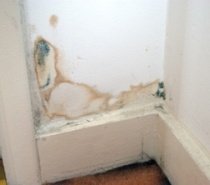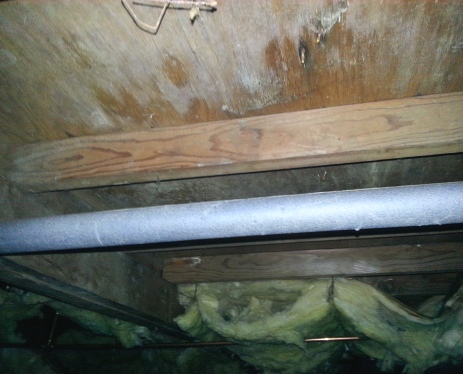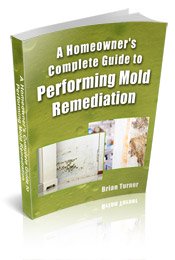Find a Mold Specialist Now
Click or Call, Toll-Free 24/7
Home Mold Remediation
Starting a home mold remediation project is a big task, especially if the mold has grown to several areas in the home. When you are dealing with remediation mold problems, it is a good idea to consult with a mold specialist in order to determine the best cleanup plan for your individual situation. This article covers the steps that should be taken during the remediation process. But keep in mind that it can be very dangerous to your health if the mold is not handled carefully, which is why a professional should be consulted.
Why Mold Cleanup is Essential

Continued exposure to mold spores can cause many serious health problems, such as respiratory infections, headaches, dizziness, autoimmune diseases, digestive problems, and even cancer. Often, these symptoms start out small, and the home owner does not realize that they are living in a toxic environment. Over time, the mold problem will become worse, and the symptoms will also worsen.
If you discover that you need to remove mold from your home, start as soon as possible in order to prevent additional health complications. Some people don’t understand how serious mold problems can be, and they choose to ignore the problem or do a partial cleanup to get rid of the visible mold. The problem is that mold spores continue to spread through the air, causing exposure to everyone in the home.
Home Mold Remediation Steps
These are a few steps to follow during the cleanup process:
- Be sure to seal off the room before beginning the home mold remediation process. Plastic sheets and tape should be used to prevent cross contamination to the rest of the home.
- A negative air machine should be used to maintain the room air pressure so that the air is flowing inward. Also, the negative air machine helps to filter mold spores out of the air.
- Protective clothing always needs to be worn during the cleanup process, including a mask, goggles, rubber gloves, coveralls, and a hair covering.
- Most porous materials in the affected area will need to be thrown away and replaced. Mold can grow in porous materials such as drywall, carpet, insulation, under linoleum, curtains, furniture, and wood.
- The area should be completely scrubbed down with a high quality biocide in order to kill the mold spores that are present.
- During the remediation mold process, use a HEPA filtered vacuum to prevent mold spores from becoming airborne.
- Fix any sources of water or dampness such as leaky pipes or condensation on the windows.
- Always consult with a mold professional who can test your home before and after the cleanup process. The test after is absolutely essential to be sure that the mold is completely gone.
- Allow the area to completely dry before you start remodeling, because any damp surfaces may be the perfect breeding ground for future mold growth.
- When consulting with a professional, follow each home mold remediation step exactly as they recommend in order to avoid mold problems in the future.
Because different surfaces may be affected, it is important to understand the remediation mold process for each type of building materials that you are working with. For example, if the mold has affected the wood structure of a home, the area should be scrubbed with a wire brush, then treated with a biocide and encapsulated. Sometimes it is necessary to use the biocide several times in order to kill all of the mold spores that are present.
Different cleaning techniques should be used for concrete, tile, and other building materials. So, be sure to understand the process completely before you begin your home mold remediation.
 White mold in crawl space.
White mold in crawl space.When You Need to Consult a Professional
In some instances, we recommended consulting with a professional before beginning the mold removal process even if you want to do the work yourself. Most mold removal professionals provide free consultations so they will assess your home and discuss the work that needs to be done at no cost to you. We recommend consulting with a professional if:
- Mold covers a surface area greater than ten square feet in your home.
- You have mold on wooden surfaces and the wood cannot easily be removed and replaced.
- You have mold in your heating and ventilation ducts, or suspect there might be mold growing in there.
- You aren’t sure why you have a mold problem (a professional can help you figure it out and help determine how to prevent mold from coming back after you remove it).
- You aren’t sure you’ve located all the mold in your home (a musty odor usually indicates mold is growing somewhere, even if you don’t see any mold).
- You have health problems, especially respiratory or immune system disorders, or are currently pregnant (a professional can provide valuable safety information).
For a list of local mold removal professionals that provide free consultations, follow this link.
Additional Reading:
Get Rid Of Mold - Information on getting rid of mold. EPA mold remediation information, recommended mold remediation equipment, and how to find reputable local mold remediation companies.
Mold Remediation Products - Information on products used for mold mildew remediation. Review of products that are safe and easy to use for do it yourself mold remediation jobs, and information on products used by mold remediation specialists.
Mold Remediation Protocol - Step-by-step guide to mold treatment. The importance of hiring professionals with mold remediation certification.
Return From Home Mold Remediation To Our Black Mold Health Symptoms Home Page





